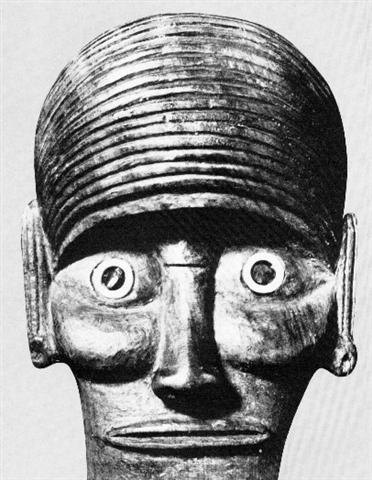Maybe choking on a fish-bone (hakaraoa) is potentially as lethal as being threatened by a spear or by a harvest implement. Pisces 'defeated' Aries around A.D. 420 according to Allen, but previous to that it could have been the opposite, because Aries could then have 'killed' Pisces (then signifiying the last part of the Sea, winter). I have one more item to present: "... One very old and worm-eaten sample (Boston 64845) has fish vertebrae inserted as earplugs. The specimen, collected by Agassiz' Albatross Expedition as late as 1904-5, has doubtless been kept hidden in a cave. A large portion of the upper blade, corresponding to the broad and tall forehead, is covered by dense rows of vertically painted stripes that may indicate hair although in some specimens they definitely assume the aspects of a feather-crown of the type common in aboriginal Easter Island ..." (Thor Heyerdahl, The Art of Easter Island.) The worm-eaten sample was a so-called dance paddle. There were 2 kinds, the ao and the ua, the large and the small paddles. I guess the ao could have been connected with the 'birth' of Sun (the front side of the year) and the ua with the 'birth' of Rain (the back side of the year).
To have fish vertebrae inserted as ear-plugs is not the same thing as choking on fish-bones, but parts of fish are found on the sea-shore. The 'timing' should be the same, where 'Sea' turns to 'Land'. If the ao paddle was connected with the time when Sun was rising and ua with the time when Rain was asked for, then it seems reasonable to have fish vertebrae as earplugs in an ao as a sign of how the Winter Fish has been defeated. The form of an Easter Island dance paddle was similar to the honu bodies in Ca5-17 and Ca8-27, which glyphs are 226 - 122 = 104 (= 8 * 13) days apart:
Possibly the first honu ure represents the beginning of the Sea and the second the end of the Sea - 'The Ram having pass'd the Sea serenely shines, // And leads the Year, the Prince of all the Signs.'
This idea would place the so-called Moon calendar out in the Sea with only the very last part of the Sea voyage up on land, from Ca8-29 (15h / 3h). 364 ('Land') + 104 ('Sea') = 468:
Manzil day 368 (= 264 + 104) is 4 days beyond day 364, when the first 3 Pleiades rose heliacally and the old year could have ended. The very special hanau figure in Gb8-26 has toes in front but a fishy fin at left. The word Zaurak (for γ Eridani) means a ship: ... Phoenix, the French Phénix, the German Phönix, and the Italian Fenice, is one of Bayer's new figures, between Eridanus and Grus, south of Fornax and Sculptor, - its α, κ, μ, β, ν, and γ in a line curving toward the south like that of a primitive Boat, by which figure, as Al Zaurak, the Arabs knew them ... In C the change from Sea to Land could evidently have been defined from the measure 354 (= 250 + 104) nights, a fortnight earlier. Yet, in C the date November 19 was at 16h and only a pair of days away from the corresponding day May 19 on the other side of they year:
We can guess the G text had 4h as the central time from where a new year could be counted and the C text a central time 12h later, but with Sheratan 5 as the date in both cases. In G Sheratan 5 could have referred to the heliacal time and in C Sheratan 5 could have referred to the nakshatra time. But I have not so far been able to prove it - the nakshatra dates could therefore be in G and the heliacal dates in C (or both text could rely either on heliacal or on nakshatra dates).
| ||||||||||||||||||||||||||||||||||||||||||||||||||||||||||||||||||||||||||||||||||||||||||||||||||||||||||||||||||||||||||||||||||||||||||||||||||||||||||||||||||||||||||||||||||||














